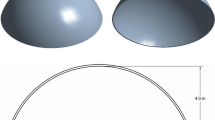Abstract
An oven is a device that generates high heat by using radiation and convection to heat food. Due to the high heat generated when the oven was operating, the door is deformed and a gap is created, and heat leaks through the gap. In this study, in order to prevent heat loss due to deformation of the oven, after we established an analysis technique that reflects the actual operating conditions of the oven in finite element analysis (FEA), an optimal shape that could prevent thermal deformation of the oven door was designed. The validity of the analysis was reviewed by comparing the results of the newly proposed finite element analysis with those of the actual measured deformation of the door. Also, the door shape that can minimize thermal deformation was optimally designed through analyzing the design parameters to be influenced to thermal deformation, using the response surface method.
Similar content being viewed by others
Abbreviations
- σ b :
-
Bending stress
- M :
-
Moment
- y :
-
Distance from the neutral axsis
- l :
-
Moment of inertia of area
- b :
-
Width of the cross section
- h :
-
Height of the cross secton
References
H. Zhang, X. Zhao, Q. Mei, Y. Wang, S. Song and F. Yu, On-orbit thermal deformation prediction for a high-resolution satellite camera, Applied Thermal Engineering, 195 (2021) 117152.
Y. Cheng, X. Zhang, G. Zhang, W. Jiang and B. Li, Thermal deformation analysis and compensation of the direct-drive five-axis CNC milling head, Journal of Mechanical Science and Technology, 36(9) (2022) 4681–4694.
J. H. Cho, M. K. Lee, S. M. Park, S. M. Hong and N. S. Kim, Prediction of thermal deformation considering the residual stresses for the PMMA-TSP laminated structure, Journal of Mechanical Science and Technology, 25(12) (2011) 3135–3140.
S. S. Kang and S. K. Cho, Thermal deformation and stress analysis of disk brakes by finite element method, Journal of Mechanical Science and Technology, 26(7) (2012) 2133–2137.
Z. Ye and S. C. Hsu, Predicting real-time deformation of structure in fire using machine learning with CFD and FEM, Automation in Construction, 143 (2022) 104574.
L. Li, L. Yan, Y. Chen, T. Pan, X. Zhang, W. Cui, A. Flood and F. Liou, Predictive model for thermal and stress field in selective laser melting process–part II, Procedia Manufacturing, 39 (2019) 547–555.
K. Ju, C. Duan, Y. Sun, J. Shi and J. Kong, Prediction of machining deformation induced by turning residual stress in thin circular parts using ritz method, Journal of Materials Processing Tech, 307 (2022) 117664.
H. Moein and I. S. Far, Different finite element techniques to predict welding residual stresses in aluminum alloy plates, Journal of Mechanical Science and Technology, 28(2) (2014) 649–689.
J. Jang, E. C. Kang, S. Jeong and S. R. Park, Experimental and numerical analysis for predicting the dehumidification performance of a hollow fiber type membrane using the log mean pressure difference method, Journal of Mechanical Science and Technology, 32(11) (2018) 5475–5481.
S. K. Park and W. J. Kim, Reduction of contraction and expansion noise of refrigerator using thermal deformation analysis, The Journal of the Acoustical Society of Korea, 38(3) (2019) 344–351.
G. Riva, F. Varriale and J. Wahlstrom, A finite element analysis (FEA) approach to simulate the coefficient of friction of a brake system starting from material friction characterization, Friction, 9(1) (2021) 191–200.
Acknowledgments
The work was supported by a 2-Year Research Grant of Pusan National University.
Author information
Authors and Affiliations
Corresponding author
Additional information
Hanbin Kim is a master’s course in the School of Mechanical Engineering, Pusan National University, Pusan, Korea. His research interests include the development of thermal deformation prediction technique and design of oven door using response surface method.
Rivaldo mersis Brilianto received an M.S. degree from the Department of Mechanical Convergence Technology from Pusan National University, South Korea, in 2019. Currently, he is pursuing a doctorate in the School of Mechanical Engineering at Pusan National University. His research interests include FEM simulation
Dongkyu Lim is a master’s course in the School of Mechanical Engineering, Pusan National University, Pusan, Korea. His research interests include flow analysis for shaft design and leakage prevention of synchro 2-speed pump.
Chul Kim is a Professor of mechanical engineering at Pusan National University, Korea. He received doctoral degree of mechanical engineering at Pusan National University in 1999. His major research fields extend into FEM simulation (structure, dynamic and fluid analysis), optimal structural design, and CAD/CAM.
Rights and permissions
About this article
Cite this article
Kim, H., Brilianto, R.M., Lim, D. et al. A study on the optimal design for preventing thermal deformation over the oven door. J Mech Sci Technol 38, 1155–1166 (2024). https://doi.org/10.1007/s12206-024-0213-y
Received:
Revised:
Accepted:
Published:
Issue Date:
DOI: https://doi.org/10.1007/s12206-024-0213-y




